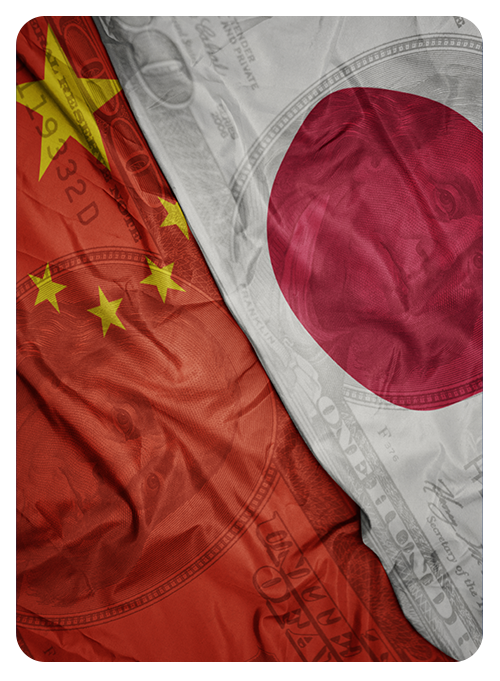Finsphere
Market Outlook:
Volatility Ahead as US Election Results Shape Global Trade Dynamics.

Dear Esteemed Clients,
Quote from our October Newsletter ‘As we embark on eventful October after strong September for equities, caution seems to be in the air.’ Unquote month of October saw sharp profit in equities across the board. US markets have thus far covered their ground on back drop of decisive mandate for US President. As we write this note it very likely Mr. Trump will get clear majority in both houses and will be sworn in as 47th President of United State of America.
Coming few months will be marked by rhetoric’s on Tariff wars, China plus 1, bilateral, multi-lateral trade agreements, new geo-political alignments and old re-alignments. Equity market loves sense of direction which maybe missing in near future leading to accentuated volatility. The stage is ripe for new economic synergies on global map. Time to be very selective, vigilant and adaptive.
United States
Robust and strengthening
The U.S. economy expanded by an annualized 2.8% in Q3 2024, while unemployment rate was stable at 4.10%. The corporate earnings season revealed strong overall performance, with 75% of S&P 500 companies surpassing profit expectations in Q3 2024. Sectorally, technology led services was the standout, with 92% of firms, including Meta Platforms and Alphabet, outpacing earnings forecasts. Consumer Staples followed, with 87% of companies exceeding expectations, signaling steady demand in essential goods. Healthcare and IT sectors also showed strength, with 85% and 81% of companies, respectively, beating estimates.
Government consumption also contributed to growth, climbing 5%, largely due to defense spending. However, fixed investment, a key indicator of economic health, showed signs of cooling. Private inventories detracted from GDP growth, while investments in structures and residential assets declined by 4% and 5.1%, respectively. Labor market data offered a mixed picture, with non-farm payroll growth slowing dramatically to 12,000 jobs in October, the lowest monthly addition since December 2020.

Job growth was constrained by external factors such as the Boeing strike and regional disruptions from Hurricanes Helene and Milton. The unemployment rate held steady at 4.1%, initial jobless claims fell to 216,000 in late October, underscoring continued labor market resilience despite slower job creation. The annual inflation rate slowed to 2.4% in September, the lowest level since February 2021.
As we look forward, US is shaping up well having enough elbow room to take care of any impending slow down.

Euro & United Kingdom:
Economic Crosswinds in the Eurozone and UK: A Cautious Recovery
In October, the European Central Bank (ECB) executed a 25-basis points reduction across its three primary interest rates, marking the third such cut in recent months. The decision is rooted in a nuanced inflation outlook, as the Eurozone sees a substantial cooling in prices. September’s inflation dipped below the ECB's long-standing 2% target for the first time in over three years—a significant achievement in the current high-rate environment. The Bank anticipates a temporary increase in inflation in the near term, yet expects it to align more closely with the 2% benchmark by 2025.
The Eurozone’s GDP surged by 0.4% in Q3 2024, marking the strongest quarterly growth in two years and surpassing the projected 0.2%. Notably, Germany defied recessionary forecasts with a 0.2% expansion, while France’s growth accelerated to 0.4%, and Spain maintained a steady 0.8% growth rate. This momentum was further supported by impressive rebounds in countries like Ireland, which saw a 2% GDP increase after a prior contraction, and Lithuania’s 1.1% rise.
On an annual basis, the Eurozone expanded by 0.9%—the highest year-on-year growth since early 2023. Consumer confidence edged up by 0.4 points to -12.5 in October, continuing to recover yet still below long-term averages. The European Union saw a parallel trend, with consumer sentiment achieving its highest level since early 2022, thanks to improving household financial outlooks.
Coming to the United Kingdom, recent fiscal developments underscored the government’s strategic pivot. Chancellor of the Exchequer Rachel Reeves announced a £70 billion fiscal expansion over five years, partially funded by £40 billion in tax hikes and £32 billion in additional borrowing. The Office for Budget Responsibility has forecast this approach to temper long-term growth, predicting a modest 1% GDP expansion for 2024, but Reeves remains committed to fiscal stability. The British economy grew by 0.5% in Q2 2024, a slight deceleration from earlier estimates but indicative of continued growth. Notably, the inflation rate fell to 1.7% in September—the lowest level in over three years—driven by transport costs and lower energy prices. The sustained drop in inflation will likely provide some relief to British consumers and businesses grappling with high borrowing costs and other price pressures.
As the Eurozone and UK confront economic headwinds, the ECB and Bank of England’s measured approach to monetary policy will be crucial in steering their respective economies through uncertainties. With inflation cooling and growth showing resilience, Europe’s policymakers have a narrow but viable path to maintain stability.
Japan and China
Asia’s Path to Recovery: Japan Balances Inflation with Stability, While China Doubles Up on Stimulus
In October, Asia’s two largest economies, Japan and China, pursued distinct strategies to navigate their economies. While Japan focused on a careful balance between inflation management and sustainable economic growth, China launched a significant fiscal push to support its beleaguered economy.
In a closely watched decision, the Bank of Japan (BOJ) held interest rates at ultra-low levels but hinted at potential tightening if conditions align with its inflationary targets. Governor Kazuo Ueda’s comments underscored the central bank’s readiness to raise rates in the future, conditional on consistent wage growth and a steady domestic economic recovery. The BOJ’s quarterly outlook indicated a measured path towards its 2% inflation goal, with expectations that inflation would stabilize near this level by 2025. In September, Japan’s inflation rate decelerated to 2.5%, the lowest since April, largely driven by moderation in energy and food costs.

Across the East China Sea, China implemented sweeping fiscal and monetary measures to counter a sluggish economy. In October, the People’s Bank of China (PBOC) reduced the one-year loan prime rate (LPR) by 25 basis points to 3.10% and the five-year LPR to 3.60%. This rate cut aims to spur economic growth by making borrowing cheaper for consumers and businesses alike. Alongside this, the PBOC introduced a new 500 billion yuan ($70.6 billion) swap facility, allowing financial institutions to apply for capital to purchase stocks.
This intervention aims to inject liquidity into the markets, signaling Beijing’s commitment to boosting capital flows and enhancing market stability. The Chinese government’s stimulus efforts extend beyond monetary easing. Authorities announced a plan to “significantly increase” debt issuance, aimed at addressing local government debt, supporting low-income households, and bolstering state bank capital. The government’s initiatives appear to be stabilizing the economy.

India
Dismal Q2FY25 Earnings Update and lackluster management guidance triggers sharp profit taking.
Earnings season is ending on a cautionary note for India. Notable, being falling consumption, higher input cost, rising cost of funds, stickier inflation and growing slippages in sub-prime segment. The central bank's shift to a "neutral" policy stance signals a watchful approach, ready to pivot in case growth slips further.
Looking ahead, the RBI has kept its FY2024-25 GDP growth forecast steady at 7.2%. Inflation expectations for FY2024-25 remain at 4.5%, with the RBI projecting a gradual decline to 4.1% by FY2025-26. The World Bank and IMF have reaffirmed India's growth potential, with projections of 7% GDP growth in FY2024-25. The IMF, while noting that pent-up demand from the pandemic has waned, emphasized India's stable macroeconomic position and sectoral shifts. Structural reforms remain a key agenda to unlock India's medium-term growth potential, including labor market improvements, trade policy adjustments, and financial sector resilience.
The GST collections reflect sustained economic activity, reaching a six-month high in October at ₹1.87 lakh crores, growing 8.1% month-on-month. Year-to-date gross GST collections rose by 9.4% compared to the previous year. The net direct tax collections have surged by 18% year-to-date. These figures align with the government's broader fiscal goals and reflect an expanding taxpayer base.
India's economic outlook remains favorable, albeit with caution around inflation and external factors. The RBI's neutral policy stance provides flexibility, while the government's fiscal and structural initiatives lay a strong foundation for sustainable growth. Balancing growth with price stability will be critical in ensuring India's continued economic resilience and attractiveness for global investors.
Conclusion
As we reflect on latest developments, it is advocating being nimble in trading and very choosy in investing. Trump’s unpredictability, The Middle East’s fragile stability and not so transparent China can de-stabilize world economic equilibrium. Being cautiously optimistic is need of hour.
Our objective remains steadfast: to navigate these shifting landscapes with a keen focus on opportunities and risks, keeping our clients well-informed and prepared for what lies ahead. We extend our gratitude for your continued trust and confidence in our guidance, and we look forward to supporting your financial goals in the months to come.
Warm Regards,
Mr. Senthilkumar Naidu
Business Head, CSec
